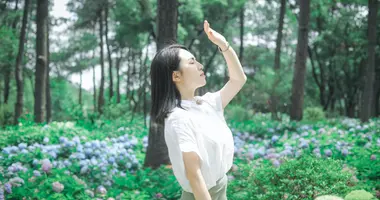Zen, a school of Japanese Buddhism 禅
- Published on : 21/01/2020
- by : J.L.T.B. / J.R.
- Youtube
Zen Buddhism or the praise of simplicity
Originally from India, Zen or the school of meditation ( dhyana in Sanskrit, chan in Chinese, Son in Korean) is one of the many branches of Japanese Buddhism. The most famous and practiced Zen is through two schools: Rinzai and Soto. Learn more about Zen, its origins and practices, and above all its essence.
History of Zen in Japan
Buddhism in Japan appears in the middle of the sixth century. This is the Mahayana or "Great Vehicle", practiced in a large part of East Asia. This stream emphasizes compassion and is grounded in the bodhisattva ideal (enlightenment being that works for the good of others by renouncing nirvana, supreme extinction).
Much later, at the beginning of the Kamakura period (1185-1333), Zen was introduced from China via the peninsula of the kingdoms of Korea by the monks Eisai (1141-1215), founder of the Rinzai and Dogen (1200-1253) sect, founder of the Soto sect.
The koan, illogical questioning, participates in the teaching of the Rinzai masters. Example: "A buffalo goes through a window. Its head, body, and all four legs have entered. Why doesn't its tail go through?" Zazen, seated meditation, and dokusan meeting a master and a disciple characterize the path of Soto.
Zen, the school of life
The goal of Zen is to intuitively achieve sudden awakening (satori). Through physical and mental discipline, training in mastery of time and awareness of space. Why? To fight an enemy within, this ignorant self, nourished by fears and illusions. The techniques and exercises of the monks strongly marked the arts and Japanese civilization, far beyond the spiritual sphere.
Practice, and only practice, leads to a spiritual and individual journey. Zen adepts reject intellectual artifices and worldly trivia. They favor the real experience, here and now, without hope or fear.
- Read also: Recharge your batteries with Zen

Zen garden of Kongobu-ji temple in Mount Koya
Aymeric Geoffre-Rouland
Zen temples and places in Japan
In Japan, the Zen temples of the Rinzai school have very beautiful gardens, often including a pond or a lake, but also the famous stone garden - which is called by metonymy "Zen garden". Also called " dry gardens " (枯 山水, karesansui in Japanese), these expanses of brushed gravel where stones are placed illustrate one of the major aspects of Zen: the desire to eliminate the superfluous.
Visiting Zen temples during a stay in Japan is a great way to approach the current Zen. They are particularly numerous in Kyoto, an ancestral city that is home to some of the most beautiful Zen Buddhist complexes in the country, but also in Kamakura.
Temples to see in Kyoto
The Kennin-ji
It is the oldest Zen temple in Kyoto, located in the historic district of Higashiyama. It was founded in 1202 by the monk Yousai. The Kennin-ji is the main temple of the Rinzai School and it was within its walls that Zen was first taught. It has two splendid gardens, a long dry garden as well as a small interior garden, the Chouontei, covered with moss, the maples of which can be admired with happiness during the kôyô.
Address: 584 Komatsu-cho, Higashiyama-ku, Kyoto
Entrance: 500 yen ($4.50/ 3.75€)
Hours: Open from 10 am to 5 pm from March to October and from 10 am to 4:30 pm from November to February
The Kodai-ji
The very pretty Kodai-ji is located not far from Kiyomizu-dera, in the east of the city. Founded in 1606 by a widow to honor her late husband, the temple shines above all for its gardens, which are part of the Cultural Heritage of Japan. These include a small stone garden, a pond, and its wooden bridge, but also a tea house and a bamboo grove. A small Zen temple, nevertheless unmissable!
Address: 526 Shimokawara-cho, Kodai-ji, Higashiyama-ku, Kyoto
Entrance: 600 yen ($5.25/4.50€)
Hours: Open from 9 am to 5.30 pm
We also recommend, if time permits, to visit Tofuku-ji, a huge Zen complex, but also Daitoku-ji, a set of temples of the Zen Rinzai Buddhist current, located to the northwest of the city.
- Related articles: Kyoto Zen temples tour
The temples to see in Kamakura
Kamakura, a seaside town easily accessible from Tokyo, is also a great center of Zen Buddhism.
The Kencho-ji
Founded in 1249, this temple is the most important of the five great temples of Kamakura. Its Sanmon gate, as well as its bonsho bell dating from 1255, is unmissable.
Address: 8 Yamanouchi, Kamakura, Kanagawa
Entrance: 300 yen ($2.60/2.25€)
Hours: open every day from 8:30 am to 4:30 pm
The Engaku-ji
This temple commemorates the memory of the fallen Japanese soldiers during the Mongolian invasion during the 13 century, very popular with the Japanese during koyo.
Address: 409 Yamanouchi, Kamakura, Kanagawa
Entrance: 300 yen ($2.60/2.25€)
Hours: open every day from 8:30 am to 4:30 pm
Finally, to experience Zen is nothing like participating in a tea ceremony, the latter being largely inspired by the practices of Zen Buddhism.
- Read also: Attend a tea ceremony in Japan




















